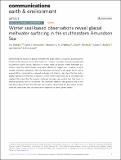Winter seal-based observations reveal glacial meltwater surfacing in the southeastern Amundsen Sea
Abstract
Determining the injection of glacial meltwater into the polar oceans is crucial for quantifying the response of the climate system to ice sheet mass loss. However, meltwater is poorly observed and its pathways poorly known, especially in winter. Here we present winter meltwater distribution in the eastern Amundsen Sea near Pine Island Glacier, revealing a highly variable meltwater distribution with two meltwater-rich layers in the upper 250 m and at around 450 m, connected by scattered meltwater-rich columns. We show that the hydrographic signature of meltwater is clearest in winter, when its presence can be unambiguously mapped throughout the water column. We argue that the buoyant meltwater provides near-surface nutrient that enhances productivity and heat that helps maintain polynyas, close to ice shelves across the Amundsen Sea. Therefore, although the processes determining the distribution of meltwater are challenging, they are important to represent in Earth system models.
Citation
Zheng , Y , Heywood , K , Webber , B , Stevens , D , Biddle , L , Boehme , L & Loose , B 2021 , ' Winter seal-based observations reveal glacial meltwater surfacing in the southeastern Amundsen Sea ' , Communications Earth & Environment , vol. 2 , 40 . https://doi.org/10.1038/s43247-021-00111-z
Publication
Communications Earth & Environment
Status
Peer reviewed
ISSN
2662-4435Type
Journal article
Description
Funding: This work is funded by the UK Natural Environment Research Council under the iSTAR Programme through grants NE/J005703/1 (K.J.H., D.P.S., B.G.M.W.); European Research Council (under H2020-EU.1.1.) under research grant COMPASS (Climate-relevant Ocean Measurements and Processes on the Antarctic continental Shelf and Slope, grant agreement ID: 741120, K.J.H., Y.Z.); National Science Foundation Division of Polar Programs and Natural Environment Research Council under the research grant TARSAN (Thwaites-Amundsen Regional Survey and Network, NSF PLR 1738992 and NE/S006419/1, K.J.H.).Y.Z. is supported by China Scholarship Council and University of East Anglia. L.C.B. is supported by a Wallenberg Academy Fellowship (WAF 2015.0186) and Swedish Research Council grant (VR2019-04400) of S. Swart.Collections
Items in the St Andrews Research Repository are protected by copyright, with all rights reserved, unless otherwise indicated.

